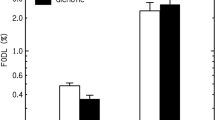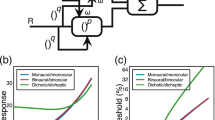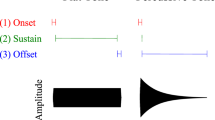Abstract
DEUTSCH1 reported an interesting auditory illusion when different tones are presented to the two ears. She used chords alternating every 250 ms between 400 Hz to the left ear, 800 Hz to the right and 800 Hz to the left, 400 Hz to the right. Subjects never heard the correct pattern; they perceived most often a low tone in one ear alternating with a high tone in the other. Right-handed subjects tended to hear the high tone in the right ear and the low tone in the left ear, but left-handed subjects showed no such tendency. Deutsch and Roll later found that right-handed subjects tended to report the sequence delivered to the right ear rather than that to the left, but the tone reported tended to be localised in the ear receiving the higher frequency2. They concluded that there were separate mechanisms for perceiving location and pitch, and that the right ear preference for pitch was related to cerebral dominance. Efron and Yund3,4 reported a related phenomenon using a sequence of two pairs of tones: 1,500 Hz to the right ear, 1,900 Hz to the left followed by 1,900 Hz to the right ear, 1,500 Hz to the left. Again most subjects heard a single note each time. Efron and Yund systematically varied the relative intensity of the two tones and found that the location of the perceived sound depended critically on this variation, always being heard towards the side receiving the more intense sound. If the two intensities were exactly balanced for an individual, then the perceived sound was subjectively located in the midline. The subjective pitch of the sound heard was a separate function from its location, and frequently the pitch of the less intense sound was heard, but localised in the ear receiving the more intense sound. We have used Deutsch's frequencies of 400 Hz and 800 Hz, and also 457 Hz and 857 Hz. We presented two consecutive pairs of tones, systematically varying the intensity, and confirmed Efron and Yund's results. Using equal intensities we obtained different results from Deutsch.
This is a preview of subscription content, access via your institution
Access options
Subscribe to this journal
Receive 51 print issues and online access
$199.00 per year
only $3.90 per issue
Buy this article
- Purchase on Springer Link
- Instant access to full article PDF
Prices may be subject to local taxes which are calculated during checkout
Similar content being viewed by others
References
Deutsch, D. Nature 251, 307–309 (1974).
Deutsch, D. & Roll, P. L. J. exp. Psychol. (Hum. Percept. Perfor.) 2, 23–29 (1976).
Efron, R. & Yund, E. W. Neuropsychologia 12, 249–256 (1974).
Yund, E. W. & Efron, R. Neuropsychologia 13, 137–150 (1975).
Tobias, J. V. (ed.) Foundations of Modern Auditory Theory 2 (Academic, New York, 1972).
Author information
Authors and Affiliations
Rights and permissions
About this article
Cite this article
CHRISTENSEN, I., GREGORY, A. Further study of an auditory illusion. Nature 268, 630–631 (1977). https://doi.org/10.1038/268630a0
Received:
Accepted:
Issue Date:
DOI: https://doi.org/10.1038/268630a0
This article is cited by
-
Deutsch's octave illusion
Nature (1978)
Comments
By submitting a comment you agree to abide by our Terms and Community Guidelines. If you find something abusive or that does not comply with our terms or guidelines please flag it as inappropriate.



